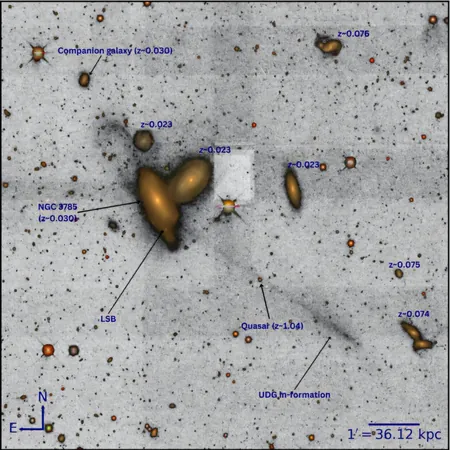
Astronomers Uncover a Stunning New Tidal Tail Linked to Galaxy NGC 3785!
2024-10-30
Author: Yu
Discovery of a Tidal Tail Associated with NGC 3785
In an exciting development in the field of astrophysics, a team of astronomers has made a groundbreaking discovery while analyzing data from the Dark Energy Camera Legacy Survey (DECaLS): a newly identified tidal tail likely associated with the lenticular galaxy NGC 3785. The results, shared in a research paper on October 24, have sent ripples through the scientific community due to the tail's remarkable extension and faintness.
Understanding Tidal Tails
Tidal tails—those mystifying, thin strands of stars and interstellar gas—are formed during gravitational interactions, often witnessed when galaxies collide or merge. Some galaxies display two tails as a result of such dynamic interactions, while others exhibit a single extension. This new finding adds to our understanding of galactic evolution and interaction.
Details of the Discovery
Led by Chandan Watts from the Indian Institute of Astrophysics in Bengaluru, India, the research team was thrilled to serendipitously discover this astonishing tidal tail within images of NGC 3785. Located in the constellation Leo, NGC 3785 appears to be an isolated galaxy, which makes this find all the more intriguing.
The tidal tail measures approximately 1.27 million light-years in projected length, earning the title of the longest tidal tail identified in such an isolated setting. But what makes this discovery truly captivating is its complex structure; the tail isn't just a straight line—it consists of both linear and looping segments. This indicates a potential gravitational interaction with a satellite galaxy, suggesting a dynamic history as it loops around and then moves southwest.
Star Formation and Ultra-Diffuse Galaxy Potential
Adding to the intrigue, the researchers documented 84 star-forming clumps along the tail, predominantly found in its fainter regions. These clumps appeared blue in the g-band image, indicating a high rate of star formation, while also hinting at the formation of an ultra-diffuse galaxy (UDG) at the tail's terminus.
Notable Quasar Discovery
Moreover, the astronomers made an exciting find involving the quasar SDSS J113923.47+261630.5, which lies behind the tidal tail, notable for its redshift of 1.04—offering a glimpse into the distant universe.
Conclusions and Future Implications
In their concluding remarks, the researchers propose a compelling scenario regarding the origin of the tidal tail. They believe it arises from NGC 3785's interaction with a gas-rich galaxy, which has the potential to morph into an ultra-diffuse galaxy at the tail's end.
This discovery not only enriches our knowledge of galactic interactions but also raises questions about the evolutionary pathways of galaxies in the cosmos. As astronomers continue to explore and analyze celestial phenomena, who knows what other mysteries of the universe await us? If you're fascinated by the universe, don't miss out on following this incredible journey through the stars!




 Brasil (PT)
Brasil (PT)
 Canada (EN)
Canada (EN)
 Chile (ES)
Chile (ES)
 España (ES)
España (ES)
 France (FR)
France (FR)
 Hong Kong (EN)
Hong Kong (EN)
 Italia (IT)
Italia (IT)
 日本 (JA)
日本 (JA)
 Magyarország (HU)
Magyarország (HU)
 Norge (NO)
Norge (NO)
 Polska (PL)
Polska (PL)
 Schweiz (DE)
Schweiz (DE)
 Singapore (EN)
Singapore (EN)
 Sverige (SV)
Sverige (SV)
 Suomi (FI)
Suomi (FI)
 Türkiye (TR)
Türkiye (TR)